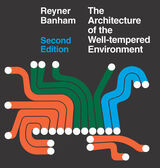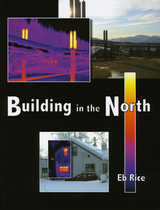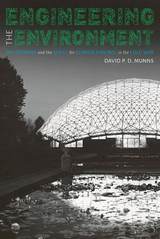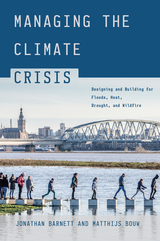5 books about Environmental engineering

Architecture of the Well-Tempered Environment
Reyner Banham
University of Chicago Press, 1984
Reyner Banham was a pioneer in arguing that technology, human needs, and environmental concerns must be considered an integral part of architecture. No historian before him had so systematically explored the impact of environmental engineering on the design of buildings and on the minds of architects. In this revision of his classic work, Banham has added considerable new material on the use of energy, particularly solar energy, in human environments. Included in the new material are discussions of Indian pueblos and solar architecture, the Centre Pompidou and other high-tech buildings, and the environmental wisdom of many current architectural vernaculars.
[more]

Building in the North
Eb Rice
University of Alaska Press, 2008
Building in the North is a fully updated edition of the classic work by Elbert F. Rice, a professor at the University of Alaska, Fairbanks, who with a steady supply of wit, charm, and his own hands-on experience helped to invent Northern engineering. Easily readable and accessible to anyone with a healthy sense of humor and a willingness to live in the beautiful North, this guide is essential for those who dream of building that longed-for cabin in the woods—or simply find themselves needing to learn to cope with the threat of permafrost in a frigid climate. Illustrated with Rice’s own drawings and filled with invaluable folk knowledge, this contribution to science and human experience in the Great North will delight adventurers and natives alike.
[more]

Engineering the Environment
Phytotrons and the Quest for Climate Control in the Cold War
David P. D. Munns
University of Pittsburgh Press, 2017
This is the first history of phytotrons, huge climate-controlled laboratories that enabled plant scientists to experiment on the environmental causes of growth and development of living organisms. Made possible by computers and other modern technologies of the early Cold War, such as air conditioning and humidity control, phytotrons promised an end to global hunger and political instability, spreading around the world to thirty countries after World War II. The United States built nearly a dozen, including the first at Caltech in 1949. By the mid-1960s, as support and funding for basic science dwindled, phytotrons declined and ultimately disappeared—until, nearly thirty years later, the British built the Ecotron to study the impact of climate change on biological communities. By recalling the forgotten history of phytotrons, David P. D. Munns reminds us of the important role they can play in helping researchers unravel the complexities of natural ecosystems in the Anthropocene.
[more]

Hope Is an Imperative
The Essential David Orr
David W. Orr
Island Press, 2010
For more than three decades, David Orr has been one of the leading voices of the environmental movement, championing the cause of ecological literacy in higher education, helping to establish and shape the field of ecological design, and working tirelessly to raise awareness of the threats to future generations posed by humanity’s current unsustainable trajectory.
Hope Is an Imperative brings together in a single volume Professor Orr’s most important works. These include classics such as “What Is Education For?,” one of the most widely reprinted essays in the environmental literature, “The Campus and the Biosphere,” which helped launch the green campus movement,and “Loving Children: A Design Problem,” which renowned theologian and philosopher Thomas Berry called “the most remarkable essay I’ve read in my whole life.”
The book features thirty-three essays, along with an introductory section that considers the evolution of environmentalism, section introductions that place the essays into a larger context, and a foreword by physicist and author Fritjof Capra.
Hope Is an Imperative is a comprehensive collection of works by one of the most important thinkers and writers of our time. It offers a complete introduction to the writings of David Orr for readers new to the field, and represents a welcome compendium of key essays for longtime fans. The book is a must-have volume for every environmentalist’s bookshelf.
Hope Is an Imperative brings together in a single volume Professor Orr’s most important works. These include classics such as “What Is Education For?,” one of the most widely reprinted essays in the environmental literature, “The Campus and the Biosphere,” which helped launch the green campus movement,and “Loving Children: A Design Problem,” which renowned theologian and philosopher Thomas Berry called “the most remarkable essay I’ve read in my whole life.”
The book features thirty-three essays, along with an introductory section that considers the evolution of environmentalism, section introductions that place the essays into a larger context, and a foreword by physicist and author Fritjof Capra.
Hope Is an Imperative is a comprehensive collection of works by one of the most important thinkers and writers of our time. It offers a complete introduction to the writings of David Orr for readers new to the field, and represents a welcome compendium of key essays for longtime fans. The book is a must-have volume for every environmentalist’s bookshelf.
[more]

Managing the Climate Crisis
Designing and Building for Floods, Heat, Drought, and Wildfire
Jonathan Barnett and Matthijs Bouw
Island Press, 2022
The climate, which had been relatively stable for centuries, is well into a new and dangerous phase. In 2020 there were 22 weather and climate disasters in the United States, which resulted in 262 deaths. Each disaster cost more than a billion dollars to repair. This dangerous trend is continuing with unprecedented heat waves, extended drought, extraordinary wildfire seasons, torrential downpours, and increased coastal and river flooding. Reducing the causes of the changing climate is the urgent global priority, but the country will be living with worsening climate disasters at least until midcentury because of greenhouse emissions already in the atmosphere. How to deal with the changing climate is an urgent national security problem affecting almost everyone.
In Managing the Climate Crisis, design and planning experts Jonathan Barnett and Matthijs Bouw take a practical approach to addressing the inevitable and growing threats from the climate crisis using constructed and nature-based design and engineering and ordinary government programs. They discuss adaptation and preventive measures and illustrate their implementation for seven climate-related threats: flooding along coastlines, river flooding, flash floods from extreme rain events, drought, wildfire, long periods of high heat, and food shortages.
The policies and investments needed to protect lives and property are affordable if they begin now, and are planned and budgeted over the next 30 years. Preventive actions can also be a tremendous opportunity, not only to create jobs, but also to remake cities and landscapes to be better for everyone. Flood defenses can be incorporated into new waterfront parks. The green designs needed to control flash floods can also help shield communities from excessive heat. Combating wildfires can produce healthier forests and generate creative designs for low-ignition landscapes and more fire-resistant buildings. Capturing rainwater can make cities respond to severe weather more naturally, while conserving farmland from erosion and encouraging roof-top greenhouses can safeguard food supplies.
Managing the Climate Crisis is a practical guide to managing the immediate threats from a changing climate while improving the way we live.
In Managing the Climate Crisis, design and planning experts Jonathan Barnett and Matthijs Bouw take a practical approach to addressing the inevitable and growing threats from the climate crisis using constructed and nature-based design and engineering and ordinary government programs. They discuss adaptation and preventive measures and illustrate their implementation for seven climate-related threats: flooding along coastlines, river flooding, flash floods from extreme rain events, drought, wildfire, long periods of high heat, and food shortages.
The policies and investments needed to protect lives and property are affordable if they begin now, and are planned and budgeted over the next 30 years. Preventive actions can also be a tremendous opportunity, not only to create jobs, but also to remake cities and landscapes to be better for everyone. Flood defenses can be incorporated into new waterfront parks. The green designs needed to control flash floods can also help shield communities from excessive heat. Combating wildfires can produce healthier forests and generate creative designs for low-ignition landscapes and more fire-resistant buildings. Capturing rainwater can make cities respond to severe weather more naturally, while conserving farmland from erosion and encouraging roof-top greenhouses can safeguard food supplies.
Managing the Climate Crisis is a practical guide to managing the immediate threats from a changing climate while improving the way we live.
[more]
READERS
Browse our collection.
PUBLISHERS
See BiblioVault's publisher services.
STUDENT SERVICES
Files for college accessibility offices.
UChicago Accessibility Resources
home | accessibility | search | about | contact us
BiblioVault ® 2001 - 2024
The University of Chicago Press









